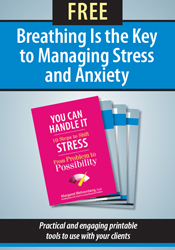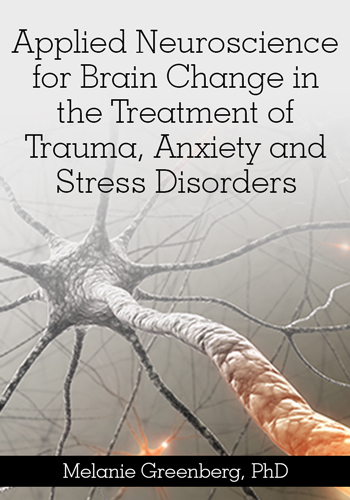Breathing Is the Key to Managing Stress and Anxiety
Simple breathing exercises can calm you down when you’re overwhelmed by stress and anxiety.

Breathing Is the Key to Managing Stress and Anxiety
You can control your reaction to stress and deliberately induce relaxation, and all you have to do is breathe. You may say to yourself, “I already know how to breathe, I’m alive.” Well, of course, you do. But when you are under stress one of the first things affected is breathing.
You may hold your breath, breathe in gulps or gasps, hyperventilate, breathe shallowly, or do some combination of these. And, chances are your stressed-out breathing is making it more difficult to respond to a stressor rather than improving your stress response.
Most people have not paid careful attention to how breathing changes when they are under pressure for a long time, such as when working on a project that is taking months to complete, caring for a sick family member, or living with someone who has an addiction. Under such conditions you may have changed your general way of breathing.
The first part of this method is to carefully observe how you breathe. Take a moment to write down what you observe about your breathing right now. Is your breathing regular in its pace on inhaling and exhaling? Do you pause in your breathing? When? Do you feel short of breath or rushed? Can you tell if you are filling your lungs or breathing into your chest only? What can you notice? Then, the next time you are under pressure, set aside a part of your attention to observe how your breathing changes when you are tense:
- If you have to speak at a meeting and that makes you nervous, notice your breathing.
- If you are having a disagreement, note how you breathe.
- If you are feeling pressured from lack of time, take a moment to feel your breathing.
It may surprise you to find that you have not been filling your lungs or that you have been holding your breath when you inhale.
Why Does Breathing Work So Well?
It may help to know that when stress is strong enough to trigger worried or anxious and panicky feelings, your body reacts without conscious intention. Your heart rate picks up, your breathing automatically increases, and changes in your adrenalin levels can make you feel shaky or jittery. You can control your breathing deliberately, and by doing so you can change all the negative physical aspects of stress.
Breathing Will Help If You Are Stressed Out by Fear
If you are panicky, whether you are in a situation that is objectively frightening or whether you are experiencing a panic attack with no objective cause, the stress response is intense, matching the degree of fear you feel. Your body is instantaneously ready to run from or fight off the cause of the fear. Fear triggers a rapid spike in sympathetic nervous system activity, increasing heart rate, respiration, and blood pressure, and decreasing blood flow to the gut. It triggers a burst of adrenalin to magnify energy.
Breathing will ward off that physical response to fear by reducing heart rate, slowing adrenalin output, lowering blood pressure, restoring blood flow to the digestive system and thereby reducing the likelihood of a headache, dizziness or stomach upset. The most important outcome of breathing the relaxed way is that it sends your body a physical message to settle down. Taking deep, slow inhalations with even slower exhalations through the mouth is a breathing mechanism to stimulate the vagus nerve, which initiates the calming action of the parasympathetic nervous system.
Breathing Is Also Important to the Non-Panicky Kind of Stress
Chronic stress causes you to tense up, giving a message to the muscles to “move!” Taking physical action to handle the problem is a natural response to an incoming stress signal. (It is not called the ‘fight or flight’ response for nothing.) However, chronic stress situations may not allow for physical responses. You might be tethered to a desk for weeks on end, kept close to the bedside of someone who is ill, or you might yourself have an injury that sidelines you. When your muscles are preparing to move, they contract, but if you then do not move them, that contraction results in tight muscles throughout your body. You will learn about muscle relaxation in the next chapter, but it starts with the breath, and, once breathing gets associated with relaxation, you can initiate immediate relaxation of muscle tension by breathing diaphragmatically.
Also, any kind of stress can make you distracted, increasing tendencies to worry over things that you cannot control. Focusing on your breath centers you, redirecting your attention to the breathing rather than the situation you are stressing out over. Your mind will start to calm down. You may also associate breath with imagery of peace. Once breathing is associated in your mind with peace, you can trigger a peaceful state just by starting the breathing pattern.
Simple to Do, Hard to Remember
Practice to Master Breathing. You’ll notice more about your breathing as you practice the following breathing technique. This technique is simple to do, but not easy to master. For breathing to effectively reduce tension, you first have to remember to use it! Until it becomes a habit, most people forget to breathe under anxiety or tension. It takes some time for this process to become smooth and easy. Breathing effectively requires practice and attention until it comes naturally. But once you have it down, this technique can be done anywhere, any time. Whether you are tense at work or home, in public or in private, you can breathe!
Click here to download a free Diaphragmatic Breathing Technique to help you manage stress and anxiety.
Excerpt from You Can Handle It: 10 Steps to Shift Stress from Problem to Possibility, by Margaret Wehrenberg, PsyD. For more information on this title, and others like it, visit pesi.com.
Make significant breakthroughs with your clients...

Practice to Master Breathing. For breathing to effectively reduce tension, you first have to remember to use it! Breathing effectively requires practice and attention until it comes naturally. But once you have it down, this technique can be done anywhere, any time. Whether you are tense at work or home, in public or in private, you can breathe!

If you’re ready to take your practice to the next level and treat trauma, anxiety and stress disorders more effectively, then check out this new online course, Applied Neuroscience for Brain Change in the Treatment of Trauma, Anxiety and Stress Disorders.
Meet the Expert:
Margaret Wehrenberg, PsyD, a licensed clinical psychologist, is the author of 6 books on the treatment of anxiety and depression, including her most recent book for the general public, The 10 Best Anxiety Busters. An expert on the treatment of anxiety and depression, she has extensive training and expertise in the neurobiology of psychological disorders. She earned her M.A. specializing in psychodrama and play therapy with children. Dr. Wehrenberg has years of experience as a drug and alcoholism counselor, working with the U.S. Army in Germany and Lutheran Social Services in Illinois. She also has training in trauma treatment, EMDR and Thought Field Therapy. She has a private psychotherapy practice in Naperville, IL, specializing in treating anxiety. In addition to clinical work, she coaches business professionals on managing anxiety, she frequently contributes articles for Psychotherapy Networker magazine, and she has produced Relaxation for Tension and Worry, a CD for breathing, muscle relaxation and imagery to use with anxious clients. Her book, The 10 Best-Ever Anxiety Management Techniques, published by W.W. Norto
Learn more about her educational products, including her upcoming live seminars, by clicking here.
Learn more about her educational products, including her upcoming live seminars, by clicking here.



